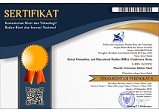Pembelajaran Sejarah Berbasis Media Online dalam Meningkatkan Kemampuan Literasi Digital Siswa di Era Revolusi Industri 4.0
Abstract
The process of historical learning in the limited face-to-face system was done by using a blended learning model. This model requires the role of online media to help synchronous and asynchronous learning process. This study aims to analyze the role of online media as the latest form of learning in improving digital literacy skills. This type of research is descriptive qualitative with a case study approach. The research was conducted at SMA N 1 Ceper using data collection methods through interviews with 20 social studies students in grades XI and XII, document analysis, and observation. The results of this study show 1) Students' readiness to learn in an online learning environment, 2) students very often use online media as a source of independent learning materials during synchronous and asynchronous learning process, 3) students use digital media for collaboration and problem solving. Thus, online media plays an important role in increasing students' digital literacy as an important ability in the era of the industrial revolution 4.0.
Keywords
Full Text:
PDFReferences
Abd Karim, R., Abu, A. G. B., Adnan, A. H. M., & Suhandoko, A. D. J. (2018). The use of mobile technology in promoting Education 4.0 for higher education. Advanced Journal of Technical and Vocational Education, 2(3), 34-39. Antoninis, Manos.,Montoya, Silvia. (12 Desember 2021). A Global Framework to Measure Digital Literacy. Diakses dari http://uis.unesco.org/en/blog/global-framework-measure-digital-literacy Ariawan, V. A. N., & Pratiwi, I. M. (2020). Digital Literacy Abilities of Students in Distance Learning. In 4th International Conference on Language, Literature, Culture, and Education (ICOLLITE 2020) (pp. 592-598). Atlantis Press. Dray, B. J., Lowenthal, P. R., Miszkiewicz, M. J., Ruiz‐Primo, M. A., & Marczynski, K. (2011). Developing an instrument to assess student readiness for online learning: A validation study. Distance Education, 32(1), 29-47. Hanik, E. U. (2020). Self directed learning berbasis literasi digital pada masa pandemi covid-19 di madrasah ibtidaiyah. ELEMENTARY: Islamic Teacher Journal, 8(1), 183. Hussin, A. A. (2018). Education 4.0 made simple: Ideas for teaching. International Journal of Education and Literacy Studies, 6(3), 92-98. Kemendikbud. (2021). PANDUAN PENYELENGGARAAN PEMBELAJARAN DI MASA PANDEMI CORONAVIRUS DISEASE 2019 (COVID-19). Kementerian Pendidikan dan Kebudayaan. Jakarta Miles, M. B., & Huberman, A. M. (1992). Analisis data kualitatif. Ozdamar-Keskin, N., Ozata, F. Z., Banar, K., & Royle, K. (2015). Examining digital literacy competences and learning habits of open and distance learners. Contemporary Educational Technology, 6(1), 74-90. Puskurbuk. (2017). Konsep literasi digital dalam kurikulum 2013. Kementerian pendidikan dan kebudayaan badan penelitian dan pengembangan pusat kurikulum dan perbukuan. Jakarta Simarmata, J., Djohar, A., Purba, J., & Juanda, E. A. (2018). Design of a Blended Learning Environment Based on Merrill’s Principles. In Journal of Physics: Conference Series (Vol. 954, No. 1, p. 012005). IOP Publishing. Tang, C. M., & Chaw, L. Y. (2016). Digital Literacy: A Prerequisite for Effective Learning in a Blended Learning Environment?. Electronic Journal of E-learning, 14(1), 54-65. Tetep, S. A. (2019). Students’ digital media literacy: Effects on social character. International journal of recent technology and engineering, 8(2), 394-399.
Refbacks
- There are currently no refbacks.





